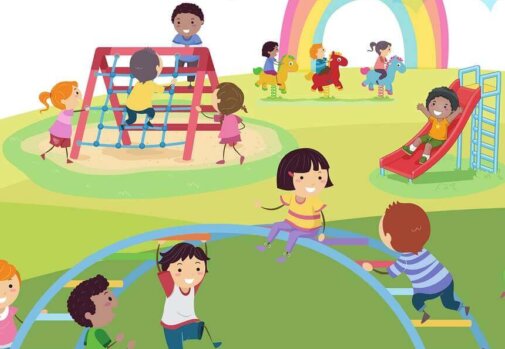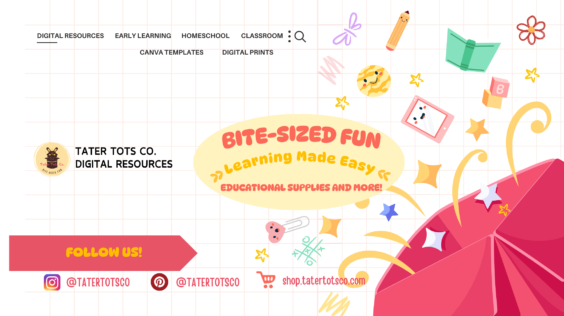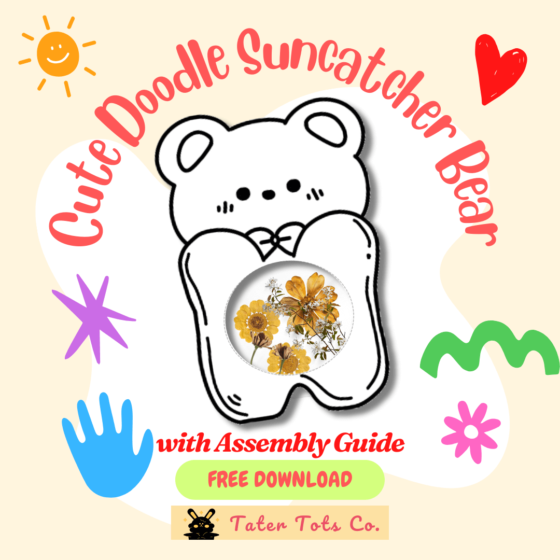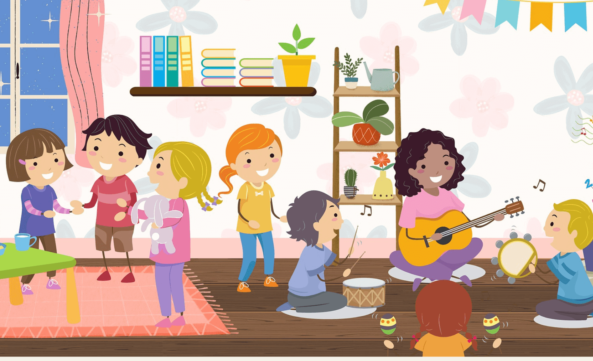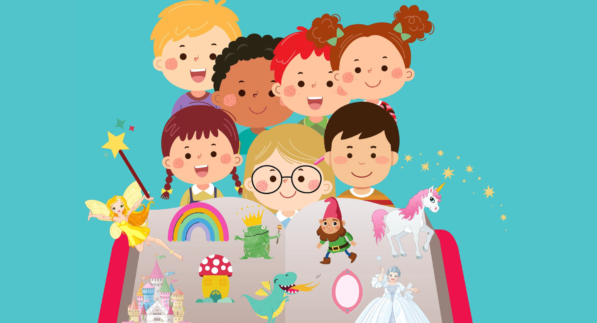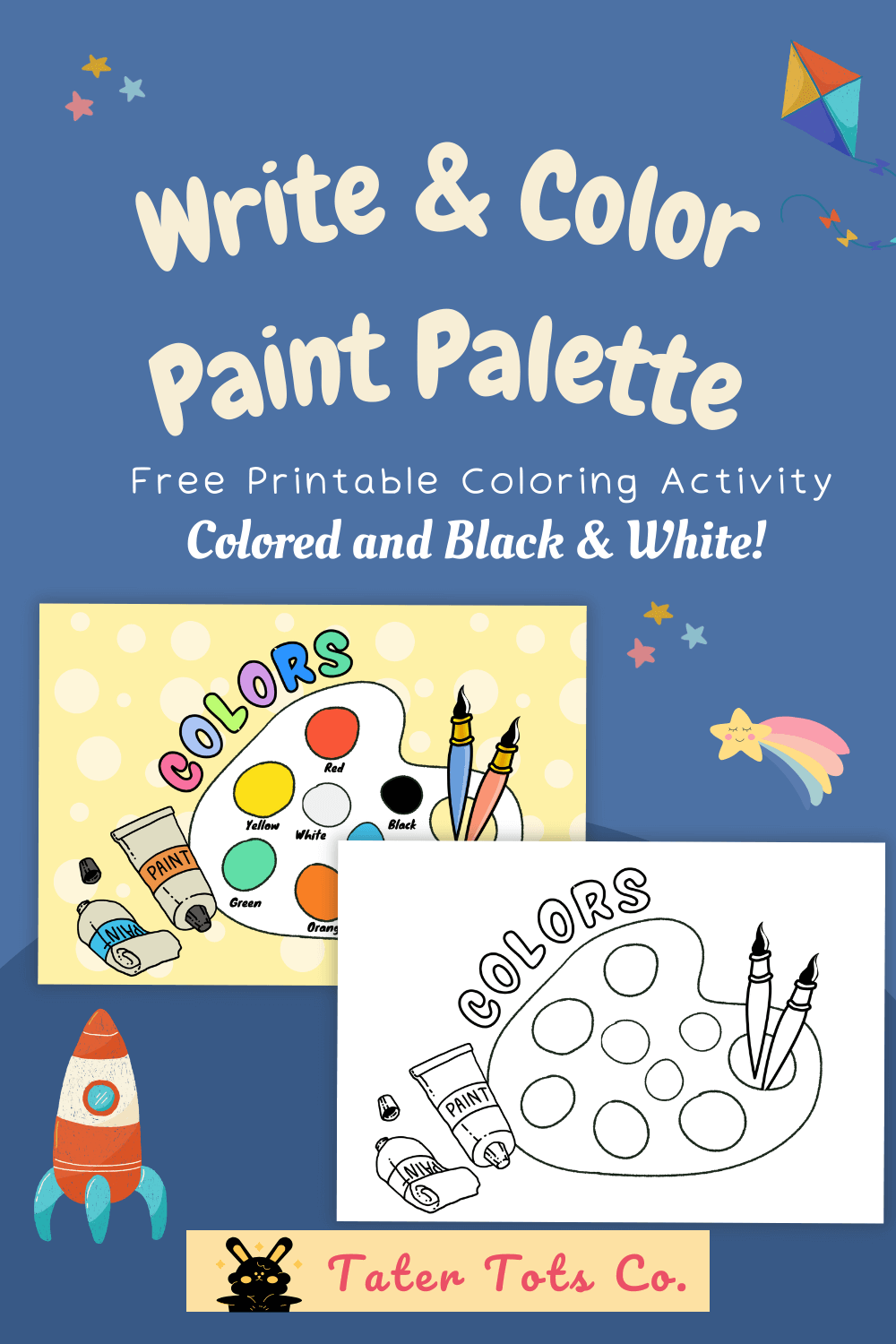
Introduction
Learning how to write can be a challenging task, especially for young learners who are still developing their skills. However, with the right tools, such as fun and engaging activity sheets, creativity can be unleashed in a way that is enjoyable and rewarding.
Activity sheets can help young learners build their writing skills and confidence, while also developing their creativity and imagination. From brainstorming ideas to creating characters and settings, we introduce some write and color activity sheets that are both engaging and inspirational and designed to help young learners facilitate the preschool curriculum.
Don’t forget to download a free printable coloring activity below with a paint palette to teach preschoolers about colors!
Introduction to the importance of nurturing creativity in young learners
Nurturing creativity in young learners is crucial for their overall development and future success. In today’s fast-paced and increasingly digital world, encouraging children to tap into their imagination and express themselves through writing is more important than ever.
Creativity is a fundamental skill that allows children to think outside the box, solve problems, and communicate effectively. By fostering creativity in young writers, we empower them to explore their unique perspectives, unleash their imagination, and develop a strong sense of self-expression.
Engaging in creative writing activities not only enhances a child’s linguistic and cognitive abilities but also boosts their confidence and self-esteem. It provides them with a safe and supportive outlet to convey their thoughts, emotions, and ideas. Through writing, children can develop their own voices and learn to articulate their experiences, which is invaluable in both personal and professional contexts.
Moreover, nurturing creativity in young learners cultivates a lifelong love for learning and exploration. It encourages a sense of curiosity, adaptability, and resilience, enabling children to adapt to new challenges and think critically. Creative writing allows them to step into different worlds, create characters, and construct narratives, fostering empathy and understanding of diverse perspectives.
In this digital age where children are often bombarded with screens and distractions, providing them with fun and engaging activity sheets can be a powerful tool to ignite their creativity. These activity sheets serve as a platform for young writers to experiment, brainstorm, and develop their storytelling skills. By presenting writing tasks in a playful and interactive manner, we can capture their interest and inspire them to explore their imagination further.
In the following sections, we will delve into various activity ideas and techniques that can unleash the creativity of young writers, providing them with an enjoyable and enriching experience on their writing journey.
Benefits of using activity sheets to unleash creativity
First and foremost, activity sheets provide a structured and guided approach to writing, which can be especially helpful for children who may feel overwhelmed or unsure of where to start. These sheets often include prompts, exercises, and creative challenges that inspire children to think outside the box and explore different writing styles and genres. By providing a clear direction, activity sheets help children develop their storytelling abilities and build a strong foundation in writing.
Additionally, activity sheets encourage imagination and originality. They invite young learners to tap into their creativity and express their unique ideas and perspectives. With engaging prompts and interactive exercises, these sheets spark curiosity and inspire children to think critically and creatively, helping them develop their own writing voice.
Another benefit of using activity sheets is that they make writing fun and enjoyable. By incorporating games, puzzles, and interactive elements, these sheets turn writing into an exciting activity rather than a daunting task. This approach not only boosts motivation and engagement but also helps children develop a positive attitude towards writing, making it a lifelong passion and skill.
Furthermore, activity sheets promote literacy and language development. They encourage children to explore new vocabulary, experiment with sentence structures, and practice grammar and punctuation rules. Through engaging activities, children enhance their reading comprehension skills, expand their vocabulary, and improve their overall writing proficiency.
Lastly, activity sheets provide a sense of accomplishment and pride. As children complete the tasks and challenges presented in the sheets, they witness their own progress and growth as writers. This sense of achievement boosts their confidence and self-esteem, encouraging them to continue exploring and honing their writing skills.
Exploring different types of activity sheets for young learners
Exploring different types of activity sheets for young learners can be a fun and effective way to unleash their creativity.
One type of activity sheet that young learners can benefit from is a prompt sheet. Prompt sheets provide a starting point for young learners by offering them a specific topic, scenario, or question to write about. This helps them overcome the challenge of coming up with ideas and allows them to focus on developing their writing skills. Whether it’s a prompt about a magical adventure, a fictional character, or a thought-provoking question, these sheets encourage young writers to think critically and express their thoughts through writing.
Another type of activity sheet that can be beneficial for young learners is a storytelling sheet. These sheets often include a visual prompt or a series of images that young writers can use as inspiration for creating their own stories. By visually representing characters, settings, and key events, storytelling sheets encourage young writers to use their imagination and develop their storytelling abilities. They can create narratives, develop plotlines, and explore different genres, all while honing their writing skills in an engaging way.
In addition to prompt and storytelling sheets, there are also activity sheets that focus on specific writing techniques. These sheets provide exercises and guidance on elements such as descriptive writing, dialogue, or character development. By practicing these techniques in a structured and guided manner, young learners can enhance their writing abilities and gain a deeper understanding of the craft.
Overall, exploring different types of activity sheets for young learners opens up a world of creative possibilities. It allows them to engage with writing in a playful and interactive way while developing essential skills that will benefit them in their learning journey. They serve as valuable tools for nurturing creativity, encouraging self-expression, and fostering a love for writing.
Fun and interactive writing games to spark imagination
Fun and interactive writing games are a great way to ignite the spark of imagination in young writers. These games not only make the writing process enjoyable but also help develop crucial skills such as creativity, critical thinking, and problem-solving.
One popular game is the “Storytelling Cubes” game. This involves rolling a set of storytelling cubes with different pictures or words on each side. The young writer then uses the pictures or words that appear on the rolled cubes to create a story. This game encourages children to think on their feet, come up with unique storylines, and incorporate unexpected elements into their writing.
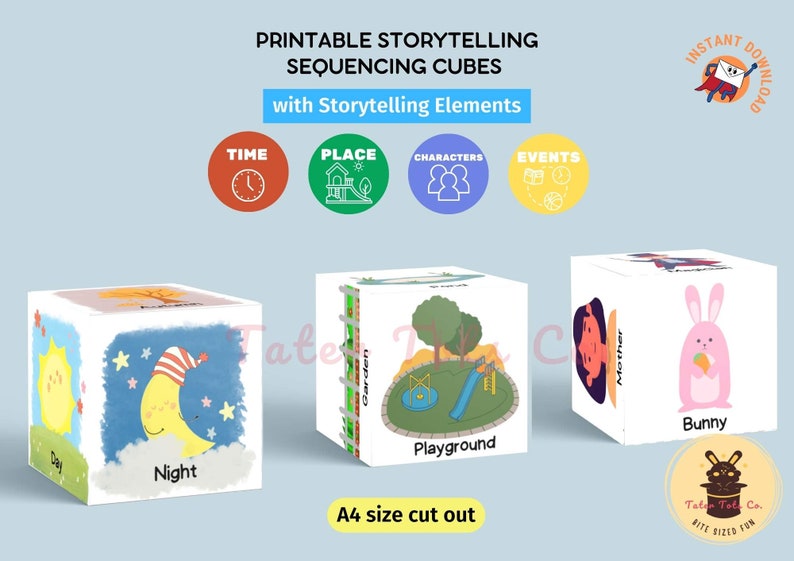
Another example is “Finish the Story.” In this game, a sentence or a short paragraph is provided as a starting point, and the child must continue the story from there. This game allows children to explore their imagination and develop their storytelling skills as they create plot twists, describe characters and settings, and craft engaging narratives.
In addition to these games, there are various online resources and activity sheets available that provide writing prompts, word association exercises, and even crossword puzzles related to writing. These resources can be easily accessed and printed, making them a convenient tool to unleash creativity at home or in the classroom.
By incorporating these fun and interactive writing games into their routine, young writers can break free from writer’s block, discover new perspectives, and expand their writing skills in a playful and enjoyable way.
Check out our section on The Best Learning Sites, Educational YouTube Channels for preschool for more links to various online resources.
Visualization exercises to stimulate descriptive writing skills
Visualization exercises are a powerful tool to stimulate descriptive writing skills in young writers. By encouraging them to imagine vivid scenes and settings, these exercises ignite their creativity and improve their ability to describe details with precision.
One effective visualization exercise is to have them close their eyes and listen to calming nature sounds, such as chirping birds, rustling leaves, or gentle waves crashing on the shore. As they immerse themselves in these sounds, ask them to visualize a serene natural environment, like a lush forest or a peaceful beach.
Encourage them to pay close attention to the sights, sounds, smells, and sensations that they imagine.
Another engaging activity is to provide a series of stimulating images or photographs and have the young writers select one that captures their imagination. Ask them to study the image carefully, taking note of the colors, shapes, and textures depicted. Then, challenge them to write a descriptive paragraph that brings the image to life, using expressive language and sensory details.
To further enhance their descriptive writing skills, you can also incorporate storytelling elements into the visualization exercises. Prompt them to imagine themselves as characters in a fantastical world, where they can create their own unique settings and characters. Encourage them to describe the sights, sounds, and emotions experienced in this imaginative realm, fostering their storytelling abilities while honing their descriptive language.
By incorporating visualization exercises into their writing routine, young learners can unleash their creativity and develop a strong command of descriptive writing. These engaging activities not only make learning fun but also equip them with valuable skills that will serve them well in their future writing endeavors.
Collaborative writing activities for creativity and teamwork
Collaborative writing activities can be a fantastic way to foster creativity and teamwork among young writers. These activities not only encourage children to work together but also allow them to explore their imaginations and think outside the box.
One fun and engaging collaborative writing activity is the “Story Chain.” Start by providing each participant with a sheet of paper and ask them to write the beginning of a story. It could be a sentence, a paragraph, or even a few lines. Once everyone has written their part, have them pass their papers to the person sitting next to them. Each participant will then continue the story based on the previous writer’s contribution. This activity not only requires creativity but also encourages participants to build on each other’s ideas, creating a cohesive and collaborative story.
Additionally, “Group Storytelling” is a collaborative writing activity that can spark creativity and teamwork. Gather a group of children and have them sit in a circle. Start by providing an opening sentence or prompt, and let each participant contribute a sentence or a few words to continue the story. As the story progresses, each participant must listen to what others have said and build upon it. This activity not only encourages creativity but also enhances listening skills and the ability to collaborate effectively.
You can create a fun and engaging environment that stimulates kids’ creativity and encourages teamwork.
Incorporating art and drawing into writing with activity sheets
Incorporating art and drawing into writing can be a powerful way to unleash creativity in young writers. Activity sheets that combine writing prompts with opportunities for artistic expression can engage children in a fun and interactive way, helping them develop their writing skills while also tapping into their visual and creative abilities.
These activity sheets can take various forms, such as story starters with accompanying spaces for illustrations, character development worksheets that encourage drawing and describing unique traits, or even comic strip templates that allow young writers to create their own narratives through both words and pictures.
By integrating art and drawing into the writing process, children are given the freedom to explore their ideas visually, which can help them generate new and unique storylines, create vivid descriptions, and develop a stronger connection with their writing. This approach not only enhances their storytelling abilities but also fosters a deeper understanding and appreciation for the written word.
Moreover, incorporating art and drawing into writing can be especially beneficial for visual learners who may find it easier to express their thoughts and ideas through images. It allows them to use their preferred mode of communication while still engaging in the writing process, ultimately boosting their confidence and overall enjoyment of the activity.
Activity sheets that encourage art and drawing in writing can be easily incorporated into classrooms, homeschooling curricula, or even used for creative writing exercises at home. They provide a structured yet flexible framework for young writers to explore their imagination, experiment with different artistic techniques, and express themselves in a multi-dimensional way.
Incorporating art and drawing into writing through activity sheets can be a dynamic and effective approach to inspiring and engaging young writers. By providing them with opportunities to blend visual and verbal storytelling, these activity sheets unleash their creativity, foster a love for writing, and empower them to become more confident and expressive communicators.
Tips for using activity sheets effectively to encourage creativity
Using activity sheets can be a fantastic way to encourage creativity in young learners. However, it’s important to use them effectively to maximize their impact. Here are some tips,
- Provide a variety of activity sheets: Offering a range of different activity sheets can help cater to different interests and learning styles. Some children may prefer visual prompts, while others may thrive with more open-ended writing prompts. By providing a diverse selection, you can engage a wider range of young writers and inspire their creativity. Check out our Write and Color Activities available in different themes below for more ideas!
- Encourage personalization: Activity sheets should not limit creativity but rather act as a starting point for young learners to build upon. Encourage them to personalize the activity sheets by adding their own unique twists, characters, or settings. This allows their imagination to flourish and creates a sense of ownership over their writing.
- Allow for flexibility: While activity sheets provide structure, it’s crucial to allow flexibility for young learners to explore their ideas freely. Encourage them to go beyond the given prompts and think outside the box. This freedom fosters a sense of autonomy and empowers them to take risks in their writing, leading to more innovative and imaginative stories.
- Provide constructive feedback: When children complete activity sheets, take the time to provide constructive feedback on their work. Highlight their strengths and offer suggestions for improvement, focusing on nurturing their creativity rather than criticizing their ideas. This feedback can help them grow as writers and build confidence in their creative abilities.
- Incorporate group activities: Activity sheets can also be used in group settings to encourage collaboration and inspire shared creativity. Consider organizing writing workshops or group projects where young writers can work together to complete activity sheets. This collaborative environment allows for the exchange of ideas and sparks new creative approaches.
- Celebrate and showcase their work: Once young learners have completed activity sheets, celebrate their accomplishments by showcasing their work. Display their stories on a bulletin board, create a digital portfolio, or organize a reading event where they can share their creations with others. Celebrating their creativity boosts their confidence and motivates them to continue exploring their writing skills.
By following these tips, you can effectively use activity sheets to encourage creativity in young writers. Remember to provide variety, allow for personalization and flexibility, offer constructive feedback, incorporate group activities, and celebrate their work.
Learn Colors with this Free Printable Write & Color Paint Palette
Unleash your child’s creativity with our free printable paint palette activity sheet. Perfect for young learners to explore colors and create their own unique masterpieces.

Our free printable paint palette is a great learning tool to help kids learn about colors and explore their artistic side. Kids can use the black and white printable to add their own color palette and spell each color’s name. It also includes a fully colored version that you can use as an educational poster.
Download the free printable Write and Color Paint Palette here.
By downloading our free printable, you agree to our Terms & Conditions of usage.
Write & Color Activity Sheets
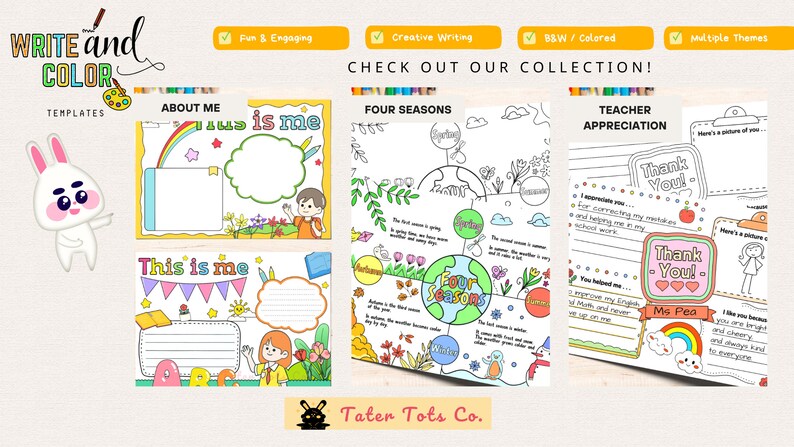
Looking for a fun and educational way to help your kids learn to spell and write their names? Check out our Personalized Name Write and Color Poster, featuring cute themes that will spark their imagination.
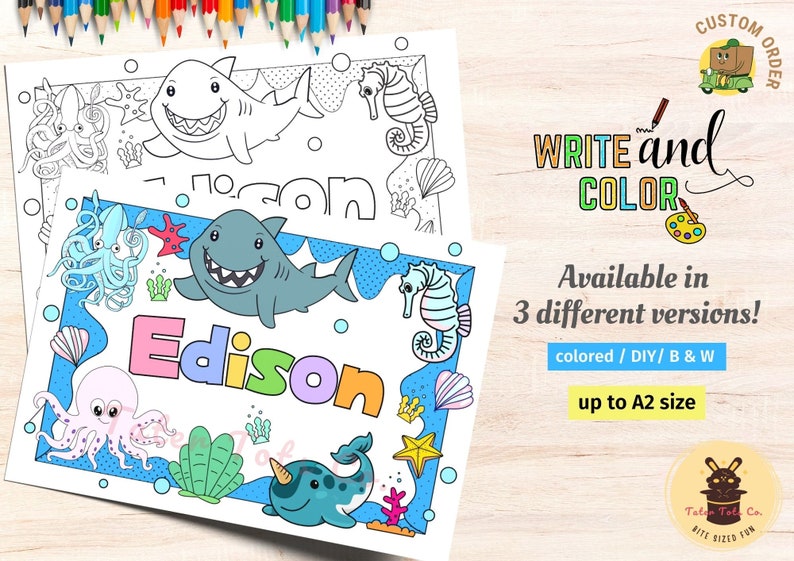

Introduce young children to healthy eating with The Simple Healthy Food Pyramid – a DIY Write and Color Poster. This teaching resource is perfect for preschool and kindergarten classrooms and provides an easy guide to nutrition. Download the PDF instantly and start learning today!
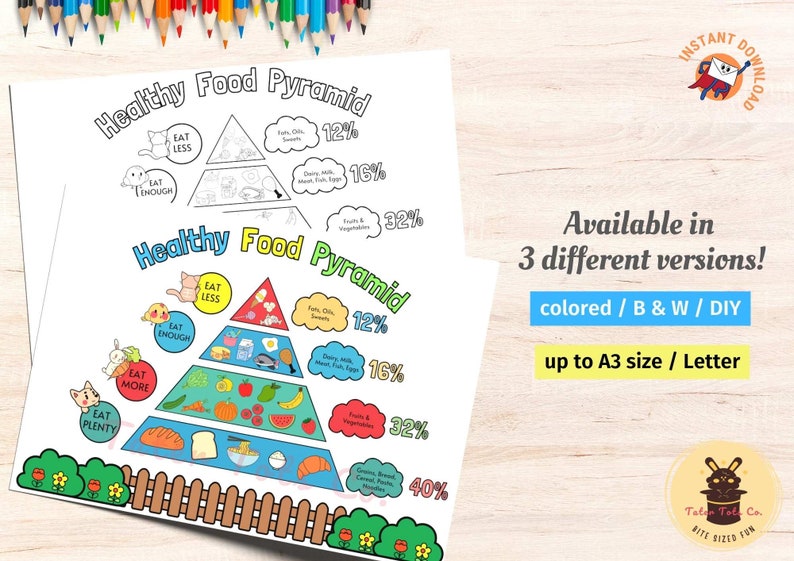
Make learning fun with our learning calendars! They include the weather, months, and days of the week, all in a colorful and engaging format.
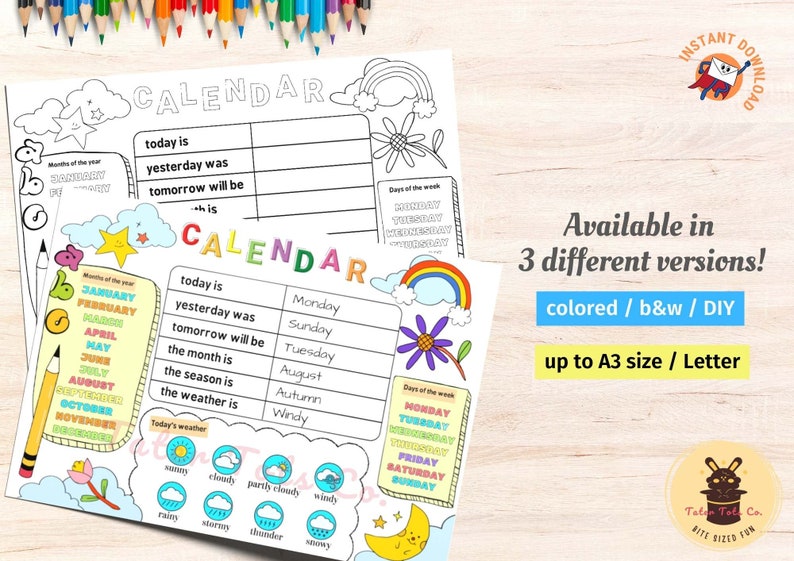
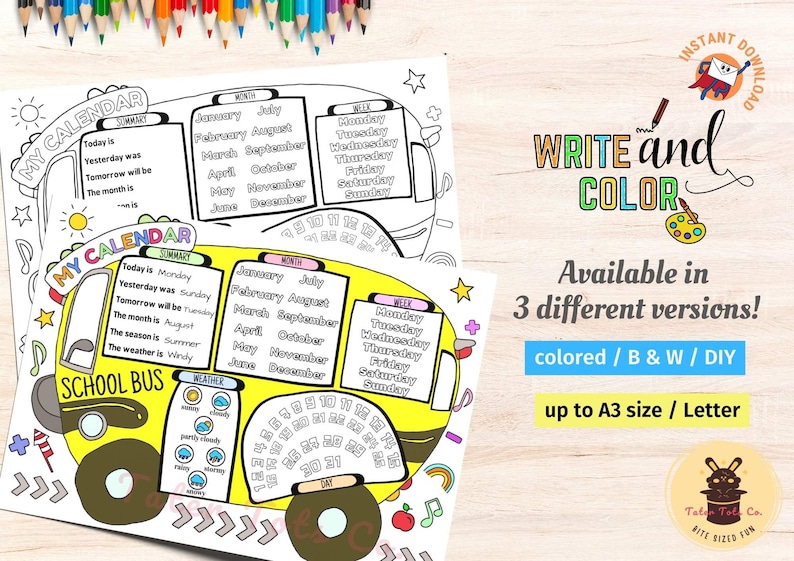
Let your child unleash their creativity as they write heartfelt messages and color this Teacher’s Appreciation DIY Poster. Comes with added writing prompts suitable for letting young kids express gratitude in a truly heartfelt way.
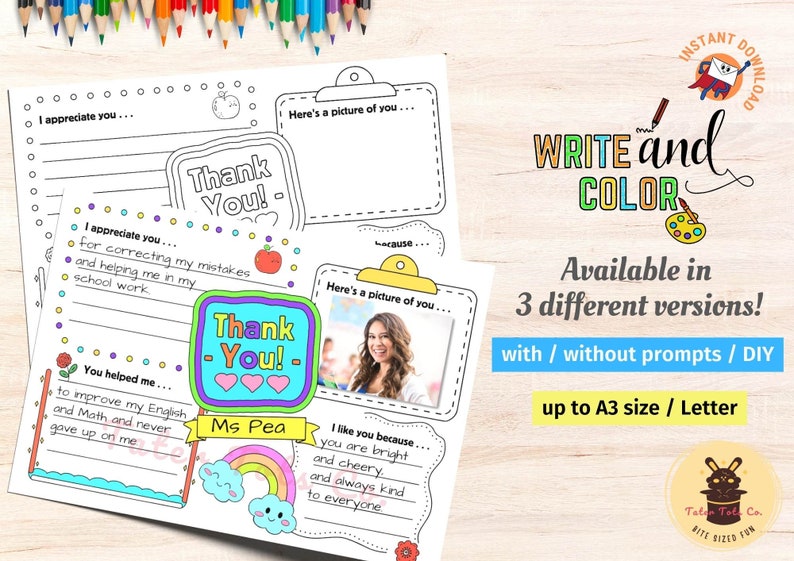
Let your child’s creativity blossom with our Four Seasons Coloring and Writing Poster Template! This seasonal activity is perfect for kids to explore their artistic side while learning about the changing seasons.
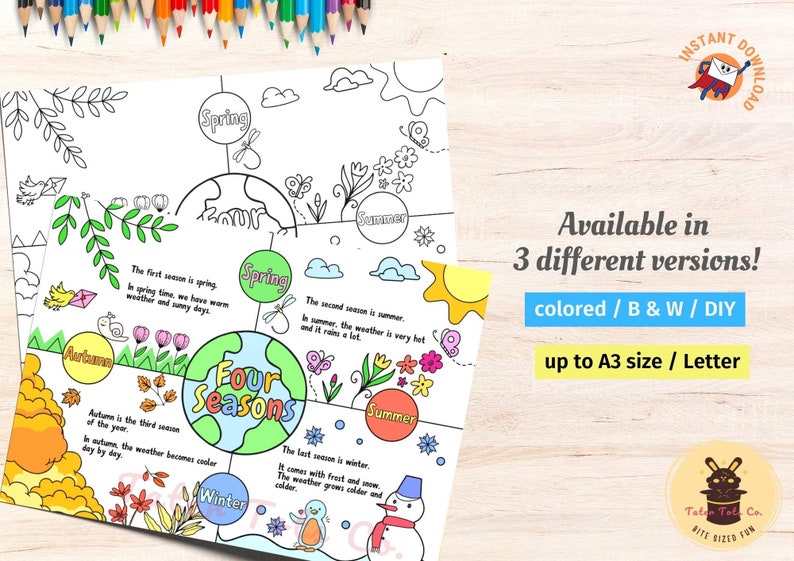
Let your child express themselves with our All About Me Color Poster Template Bundle! This template is helpful to introduce themselves and share their unique personalities and let their self-expression shine!
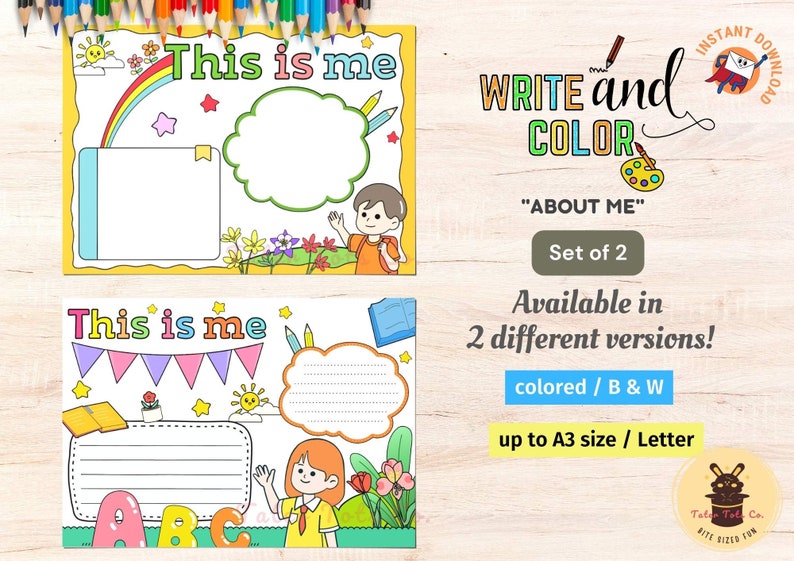
Get ready for the holidays with our Cute Christmas Monster/Yeti Vacation Plan! This DIY Write & Color Holiday Schedule is perfect for kids to plan their vacation activities and get into the festive spirit.
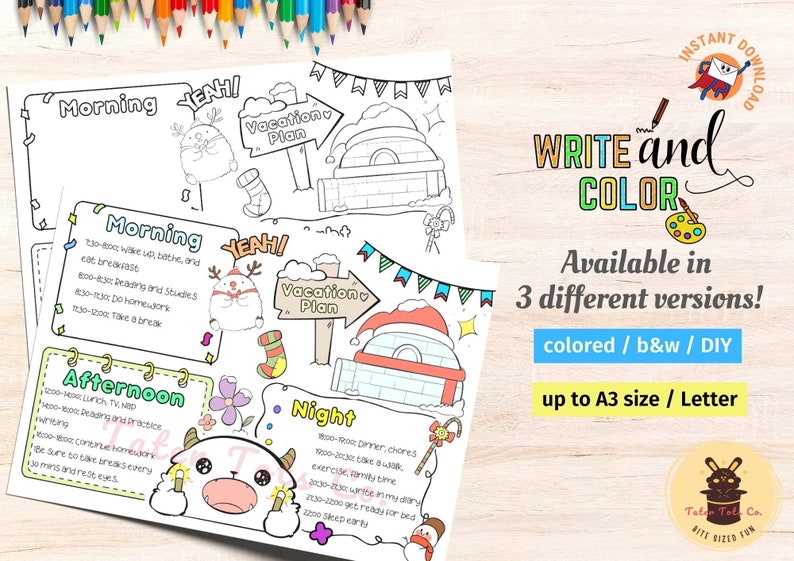
Help kids organize their thoughts with our Mind Map Write and Color Templates! This simple graphic organizer is a useful resource for the classroom and kids’ note-taking.
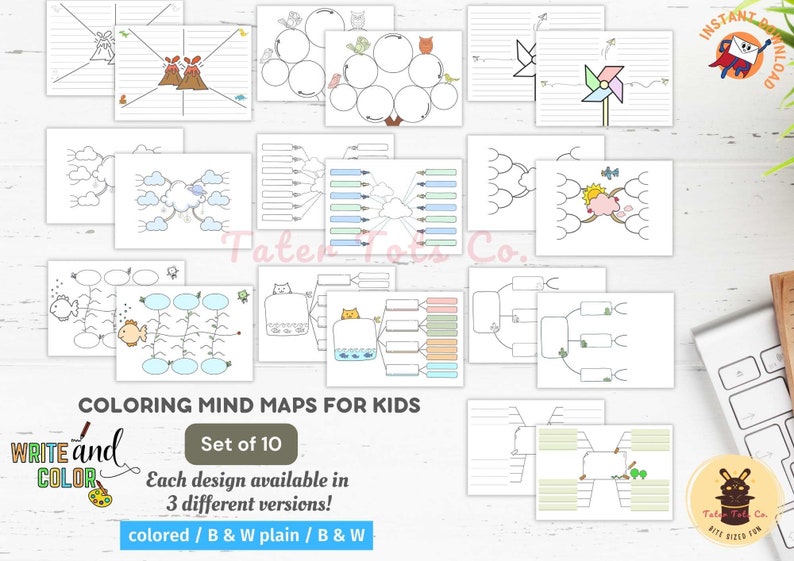
Keep children’s eyes healthy with our Eye Care Coloring Poster Page! This fun and educational activity teaches kids about healthy habits for eye care.
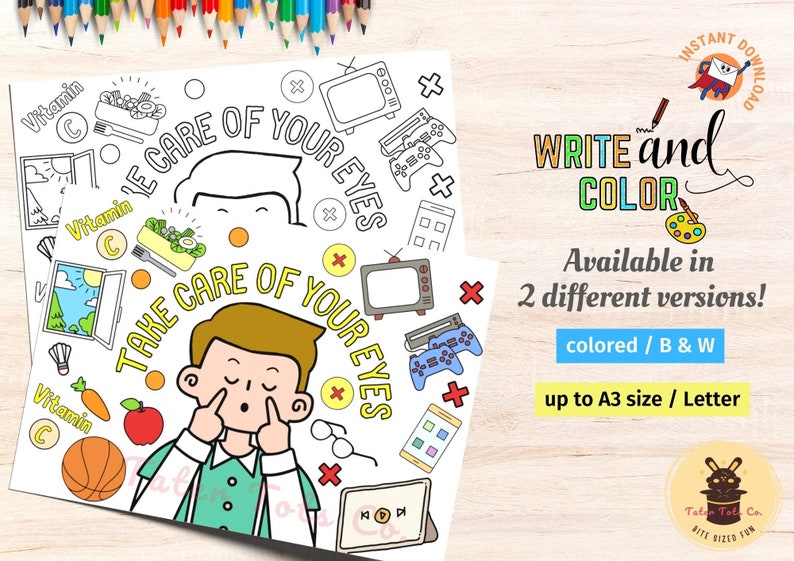
Discover the wonders of nature with our digital butterfly lifecycle poster! This engaging teaching resource is designed for young students to write and color, helping them learn about the different stages of a butterfly’s life cycle. Available for instant download in PDF format, this poster is a fun and educational addition to any classroom or home learning environment.

Conclusion
In conclusion, nurturing creativity in young learners is a crucial aspect of their development. By providing them with fun and engaging activity sheets, we can unleash their imagination and help them explore the depths of their creativity. These activity sheets not only serve as a source of entertainment but also as a platform for honing their writing skills.
It is important to remember that every child has a unique style and voice. Encouraging them to express themselves freely and without judgment will foster their confidence and love for writing. As parents, teachers, or mentors, we have the responsibility to create a supportive environment that celebrates their creativity.
By incorporating these strategies and ideas into their routine, we can inspire kids to think outside the box and embrace their individuality. Let their stories unfold, characters come to life, and worlds be created on paper. Emphasize the joy of the creative process rather than the end result, and watch their enthusiasm and passion for writing flourish.
We hope you found our article on unleashing creativity with fun and engaging activity sheets for young learners inspiring and helpful. Encouraging creativity in children is essential for their development, and these activity sheets are a fantastic way to spark their imagination and enhance their writing skills.
Whether it’s through storytelling, drawing, or word games, these activities will engage and entertain kids while nurturing their creative abilities. Happy learning and writing!

Enjoyed this freebie? Don’t forget to follow us on Facebook/Pinterest for the latest blog updates, freebies, and Ukulele printables
[menu_in_post_menu menu=96 style=”list”]
Warmest Regards,